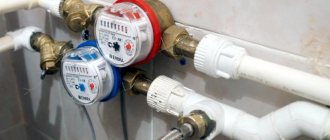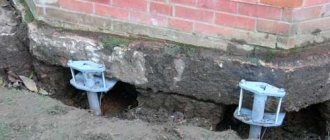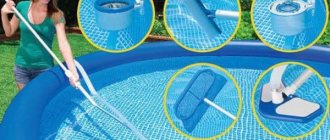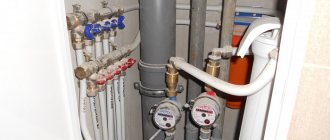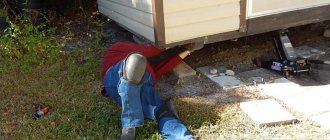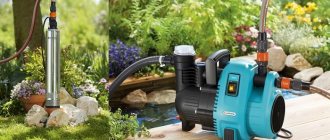It always seemed to me that water supply in the modern world is where people live. But recently I got a job as a driver at the post office.
That is, I distribute all sorts of newspapers, letters and other things throughout the villages and urban-type settlements of our region. Some of these settlements, to my surprise, live without electricity, or only some owners live without it, but in general the village has it.
In this regard, I was surprised by how people get water. They, of course, have wells and wells, but they raise this water in a variety of ways without the use of electric pumps.
These are the devices that caught my eye.
A story from our regular subscriber Dmitry.
Piston pump
I don't know if it's possible to do such a thing myself. But I was wondering on the Internet how much such a pump could cost. Prices vary quite a lot.
Starting from 5,000 rubles, ending with 15,000 and above. There are very expensive ones, but they run on electricity.
Those that I saw in the villages, of course, were still made in the Soviet Union. Now I don’t even know where these can be bought. Probably only if someone has it lying around. Its operating principle is quite simple.
Inside there is a cylinder and a piston. When the piston rises, a discharged cavity is created under it, into which water is sucked.
It is worth understanding that this device has valves both on the suction pipe and at the point where water is supplied to the outside. That is, when the piston lowers, one valve prevents that water from flowing back out, and the second opens so that the water comes out.
Diagram of a piston pump.
I once wanted to draw water using such a device, and I realized that for daily use I would have to physically work like this. The problem is that the water flows in gusts and in an inconsistent stream. It's a little disturbing.
A woman demonstrates to me how to use a piston pump.
Important! The pressure problem is solved by other models of the device, which has several pistons
Why is this event required?
The structure definitely needs cleaning, since the brown-colored liquid released to the surface is absolutely unsuitable for domestic and agricultural needs. Imagine how moisture, over centuries, formed its path deep underground, making its way between various layers of rocks, thereby being purified naturally and enriched with various minerals (this depends on the geographical latitude of our country). And here, overnight, the movement of the riverbed changed; accordingly, the liquid rushes to the surface and at the same time swirls the soluble and insoluble inclusions and organic matter found in its whirlpool. In addition, silt deposits and large volumes of sand can accumulate at the bottom of the column in the source. The only way out of this situation is to pump out the dirty substance.
Rod (or rod) pump
This can be said to be an analogue of a piston pump. Outwardly, you can’t tell them apart. I once made the same mistake in a conversation with a local resident of one of the villages. But he corrected me and explained what their differences are.
Rod pump in one of the villages.
The cost of such a pump will be slightly higher. I don’t think you’ll find any copies for less than 10,000 rubles.
The fact is that such a pump is used for wells and wells whose depth is more than 10 meters. That is, you will have to pay extra not for the mechanism itself, but for the larger length of the pipe to get to the water intake.
Rod pump diagram.
The water here does not immediately flow out through the outlet pipe. First, it fills the entire space of the pipe, which is located next to the working mechanism (piston).
As they explained to me, conventional piston pumps are used at depths of up to 10 meters. At my dacha, for example, I have a well 15 m deep (though it also has an electric pump). But my neighbor across the house already has 25 m. Although the water is the same.
By the way, this principle is also used in oil wells.
Reasons for decreasing water level in a well
When ordering drilling operations, owners of suburban areas are notified of the average rates of natural wear and tear of sources in the region. Thus, a sand well lasts approximately 10–20 years, an artesian well – 50–70. Of course, if the work is done well. However, it must be remembered that the soil contains several aquifers, separated from each other by clay or shale layers.
The following circumstances may arise:
- displacement of the aquifer due to seismic shift of layers;
- lowering of the upper water layer due to a vein breakthrough.
The listed factors can lead to complete depletion of the source without the possibility of restoration. Although this rarely happens, it is important to understand why there is suddenly little water in the well and what to do about it.
A decrease in flow rate occurs for several reasons.
- Drying out of a sandy or Abyssinian well in the summer.
We are talking about the level of location of the water intake point relative to the surface of the earth and other aquifers. Installing a water source on high water or on sand is the most unfavorable option. These formations have low pressure or no pressure at all, so their resource depends on the amount of precipitation. The more precipitation there is, the higher the water table is located.The flow rate is seriously reduced during dry seasons. It should be borne in mind differences in atmospheric pressure, at which the amplitude of water in the formation often reaches 1 meter. In addition, when water is withdrawn from one reservoir by several neighboring areas, there may not be enough resource for everyone. The issue arises especially acutely during the dry season or the period of gardening work.
When the water source is built on limestone, the water quality is better and the formation is pressurized. But even in this case, two or three adjacent wells may suffer in terms of productivity.
- Problems with the filter.
A decrease in the volume of water in the sand mine can occur due to improper arrangement of the filter system. So, if the size of the mesh cells that covers the lower end of the column is chosen incorrectly, a number of natural problems arise. Holes that are too small quickly become clogged with sand (colmatage), which reduces the overall productivity of the well. If the cells are too large, sand fills the entire lower part of the casing. As a result, the free flow of water becomes impossible. When the filter mesh breaks, the same thing happens.There are no windings on the filter in an artesian source. But here a collapse of limestone layers can occur and the well string may be blocked. Water will not flow into it.
- Errors in well operation.
The more and longer the source is used, the better it works. Regular pumping of water prevents siltation of the lower part of the casing. If the well is used exclusively seasonally, during the idle period the filter silts up and requires washing. Without this, after winter the well will produce little water.It is often a mistake to overestimate the performance requirements of a source. This is expressed in the installation of an overly powerful pump, which draws more water than the well can produce according to the documents. If the water moves too quickly, the sump pocket located under the filter becomes clogged. It becomes clogged with rock particles, causing the casing to become clogged in its lower part. As a result, a decrease in the diameter of the water receiving part of the charge.
This is interesting!
Turbid water from a well: causes and solutions to the problem Read more
The pump should be selected in accordance with the technical documentation for the water source, which specifies the characteristics of its performance and power.
Airlift
At one time I made this device myself. Back then I didn’t have an electric pump at my dacha. All I needed was a piece of plastic pipe and a hose.
I used a pipe with a diameter of 40 mm. I bought it for 120 rubles. per meter Well 15 m, plus one on top. Do the math for yourself. The hose cost 130 rubles. per meter In total, about 3,000 rubles. But this is without a pump that will supply air.
The operating principle of an airlift.
In general, you need to attach a hose to the bottom of the pipe (the one that will be in the water). Air will be supplied through it into the pipe cavity. As a result, water foam will form, which will flow to the top.
The principle is very simple and does not require much effort to create the device. True, I used an electric compressor.
First the sand rises, and then clear water comes.
You can use a hand pump, but of course, this will require a lot of energy. Although if water is needed, people are not ready for that.
I was pleased with my result, but the electric pump I then purchased turned out to be much preferable.
Stages of well build-up after drilling
If you have entered into an agreement with a professional source development company, then include a clause in the agreement regarding the provision of cleanup services. This way you will save a lot of time and money. If refused, you will have to perform the operation yourself.
Getting ready for the process
Citizens of Russia who do not have the financial ability to pay for the service of a firefighting or sewage disposal truck are faced with a pressing question: where to get a large container for transferring dirty substances.
There is an effective method that has been proven over the years - digging a special pond-sump. If you turn on the pump every hour (except at night), and let it run for two/three minutes, the sump will not overflow. But when the flow begins to flow continuously, then you can supply water to the house.
Choosing equipment
MBFT-75 Membrane for 75GPD
SF-mix Clack up to 0.8 m3/h
SF-mix Runxin up to 0.8 m3/h
Put aside the purchased submersible device intended for pumping drinking liquid until better times. It is not suitable for dirty work, since not all models can withstand excessive load. Large inclusions will instantly clog it, and you will end up with a non-repairable item. For pumping, it is better to purchase a pump with a centrifugal operating principle. Get advice on your choice from competent companies, such as Voda Otechestva. Experts will tell you why you should not buy snail-type submersible devices or vibration options, and will select the most suitable inexpensive unit for your purpose. Retail chains offer special products designed for moving dirty suspensions. They are called “fecal and drainage”. These gadgets are perfect for pumping out substances that have many foreign inclusions. But it is worth paying attention to the maximum possible lifting column. Since such products are usually not able to create sufficient pressure.
Pumping the well
We proceed to the important operation for which the preparatory work was carried out:
- Typically, the pump is equipped with a long cable. Check whether this is enough to complete your task. Otherwise, it is necessary to eliminate the problem by extension.
- The drainage device lowers to the level of suspended matter with the possibility of slow immersion. This ensures correct operation without overload.
- If possible, it is necessary to position the object in the center of the well so that it does not touch the walls. This will allow optimal removal of sediment.
- During the process, you need to monitor productivity; if it decreases, you will have to lift and rinse the device.
- All these actions are performed until a clean flow is obtained.
Important points
When extracting water by increasing pressure inside the mine, several important factors must be taken into account. Firstly, the geological structure of the area where the well is located is taken into account.
Also important is the flow rate of the mine for extracting liquid from the ground and the productivity of the aquifer.
And, of course, the depth of the aquifer is taken into account.
If all this is not taken into account, the well may fail due to excess pressure. Simply put, liquid from the aquifer will stop flowing into the mine. This is due to the fact that the air formed inside will push almost all the water down, pressing it into the ground. Therefore, the air supply must be optimal. It should only be enough to push the water out and not create excess pressure.
Causes of siltation and how to eliminate them
To know how to properly pump dirty water, it is important not only to purchase a suitable pump for pumping a well with low flow rate, but also to study the causes of contamination. If the liquid is constantly filled with sand, as a preventative measure you can use the idle method or run the pump for a couple of hours and pump out the liquid.
When figuring out how to properly pump a well, you should take into account the recommendations of specialists, which are suitable for most cases.
So, someone pumps the well with their own hands using a fire hose. This technology allows large volumes of water to be supplied inside and break up major contaminants or partially wash them out to facilitate further cleaning. The method is quite interesting, but is only suitable for those structures that have been in use for a long time, but for some reason require re-processing.
You can understand how to pump a well from clay right on site after completing the drilling procedures. For example, in addition to pumping the well with a compressor, you can use the technology of manual processing with a bailer. It is a heavy metal object that is sunk to the bottom of a structure to break up dirt and sand. Then the bailer is taken out, released and thrown back.
The well is also pumped using a vibration pump and motor pumps from Caiman, Hitachi, and Honda. Such devices sell for a couple of thousand dollars, but justify their cost with high efficiency and reliability.
Knowing how to pump a well on clay or sand, you can safely revive a hydraulic structure and protect the residents of your home from drinking dirty, silty and unsafe liquid.
Design #2 – manual pump with direct spout
A very simple device for pumping water from a barrel or a shaft well. The advantages of this design: speed of assembly, low cost.
Required parts:
- PVC pipe d.50mm – 1 pc.;
- PVC coupling d.50mm – 1 piece;
- PPR pipe d.24mm – 1 pc.;
- PPR branch no. 24 – 1 piece;
- PVC plug d.50mm – 2 pcs.;
- piece of rubber, diameter 50mm, thickness 3-4mm – 1 piece;
- check valve 15mm – 1 piece;
- empty silicone bottle 330ml – 1 piece;
- tightening screw clamp – 1 piece;
- screw-nut or rivet – 1 piece;
- union nut no. 15 – 1 pc.
We begin the assembly of the entire structure with the manufacture of a check valve.
Construction of a check valve. We prepare a check valve from a Ø 50mm plug. We drill several holes around the perimeter of the plug Ø 5-6mm. In the center we drill a hole of suitable diameter for a screw-nut pair or rivet.
On the inside of the plug we place a rubber disk Ø 50mm. The disc should not rub against the walls of the plug, but should cover all drilled holes. We tighten it in the center with a screw-nut or rivet; a screw will not work. If difficulties arise with materials or manufacturing, you can replace it with a factory-ready check valve.
What a factory-made check valve used to operate a pumping station is is described in detail in the article we recommend.
Preparing the pump sleeve. The length of the sleeve should be commensurate with the depth of the well or container with water. We cut the PVC sewer pipe Ø 50mm to the required length, from the narrow end. We insert the newly made valve into the pipe socket. For reliability, we fasten it on both sides with self-tapping screws.
For the second end we prepare a plug with a pre-drilled hole Ø 25mm. This hole in the plug is made according to the diameter of the PPR pipe Ø 24. Great precision is not required, the plug serves as a sliding support.
Piston assembly procedure. Cut off the spout of an empty silicone container. Next, you need to heat the balloon and insert the sleeve into the PVC so that the diameter of the balloon exactly matches the diameter of the sleeve. Place the silicone can on the valve from the reverse side of the arrow (the arrow on the check valve shows the direction of water movement).
We cut off the excess balloon. We secure it with a union nut no. 15.
Pump rod design. The length of the rod should be 50-60 cm greater than the length of the sleeve. You need to heat one end of the rod and insert a check valve. The arrow on the check valve should point towards the inside of the stem. Until the pipe has completely cooled down, we tighten it with a screw clamp.
Final assembly of the pump. We insert the rod into the sleeve and attach a plug (sliding support) through the coupling on top. To top it off, we attach a 24mm PPR bend to the end of the rod pipe. All you have to do is connect the hose and you can pump water.
The pipe material can be any, and the cross-section is not necessarily round. It is important to select the appropriate piston for the liner
The outlet serves as a support for the hand. For convenience, you can take a tee and plug one side of it.
Possible solutions
In addition to independently assembling a simple hand-held water pump, if you need to constantly use the pump in the absence of electricity, you can use specialized production automation for pumping equipment. Such automatic battery units are sold in specialized stores and are connected to pumping equipment using a cord and relay, eliminating the need to use electricity to operate the pump.
There are quite a lot of options for assembling and installing pumping equipment without using electricity: from the simplest home-made options that do not require any special knowledge, to thorough regular systems that operate automatically. Finding the right device will not be a difficult task.
Briefly about the main thing
A private well on your own property is a useful and absolutely necessary thing. However, it will require some periodic maintenance work for cleaning and rocking. It is described above what pumping is, what it is used for, what pump to pump the well after drilling, how to do it correctly and in what way, and what are the features of using this or that option. The issues of preparing the device for long-term downtime (wintering) and restoring performance after this period are also mentioned.
Ratings 0
Real benefits
In fact, it is not exactly a pump, but rather a pressure amplifier. This is due to the fact that it requires a certain pressure to work. This type of product is also called “hydrofor”, because both have a water seal that opens and closes the valve when a certain pressure is reached. The receiver must always be in an upright position.
According to some tests, the pump calmly draws water from streams and lakes, but not at great speed. For those who often have to go to the river for water, creating such a pump is quite a good and thorough task.
But it is better to use such a pump not on its own, but in conjunction with several such pumps: they will not interfere with each other, but the amount of water will be much greater.
Plus, you can combine them at the outlet into one water supply pipe, but the main thing to remember: the pipe must be twice as wide in diameter if there are two of these products. This is due to the fact that the basic operating principle of such a design may be disrupted and the pumps will cease to function normally.
Why can a well silt up?
Sooner or later, any hole collects solid particles and closes. Approximately the same processes occur in any trunk. Groundwater flows only in the direction of pumping; everything that it brings with it precipitates to the bottom of the source. If the surrounding rock is prone to washing away, then you will have to deal with this problem constantly. Only the installation of filter systems can cope with this for a certain time. Limestones, sandstones and a fairly large number of rocks provide stable access to liquid without impurities.
Another important problem can be considered the rare use of the source. The entire surface of the earth tends to be a perfect sphere and over time, gravitational forces will tighten the mine if you do not make any efforts to prevent this.
Design #12 – “homemade” for a small stream
This pump can operate on an ultra-low amount of energy. Of course it’s good if there is a river or lake. But what to do if the river becomes very shallow in the summer? A swing type pump will help.
Such a pump allows you to use very small amounts of energy from a small stream.
The main part of the structure is two buckets rigidly connected to each other through blocks (4). It is necessary to make a drainage system from the stream from galvanized steel (3). In order to reduce wear, a piece of plastic is placed under it. The drainage system is rigidly connected by a leash to a rope (5).
Leash 6 is made of rigid wire and the length is calculated so that the drainage system moves to the desired angle
The entire system must be adjusted so that when one bucket is filled, the drainage moves to the second bucket. The energy of the buckets is transmitted through the crank (8) to the pump (10).
Homemade pump for pumping water: a selection of the 7 best options
After purchasing a plot of land, the summer resident begins to solve the most important problems: you need to start somewhere in order to settle down. The most important thing is to provide yourself with water. Indeed, since life arose in water, without it, all living things cannot exist for a long time. You can bring water from somewhere, but only for personal needs. The watering problem cannot be solved using this method. It’s good if there is water at least close to the site. Any, even small, body of water will suit you: a river or at least a stream. The ideal option is a spring, but such luck is rare. All that's left is to get a pump. By the way, at first, a homemade water pump will do. Its use will alleviate the problem.
Option #1 - American river pump
This pump model, which does not require electricity to operate, can be used by craftsmen who are lucky enough to purchase a plot of land on the banks of a small but very stormy river.
The hose is laid in the barrel in even turns without creases or kinks. And the entire structure as a whole looks rather simple, but with its help water is regularly supplied to the shore
To create a pump you will need:
- a barrel with a diameter of 52 cm, a length of 85 cm and a weight of approximately 17 kg;
- hose wound in a barrel with a diameter of 12mm;
- outlet (supply) hose 16mm in diameter;
There are also restrictions for the immersion environment: the working depth of the flow should not be less than 30 cm, the speed of water movement (current) should be 1.5 m/sec. Such a pump ensures that water rises to a height of no more than 25 meters vertically.
Components: 1 - outlet hose, 2 - sleeve coupling, 3 - blades, 4 - polystyrene foam floats, 5 - spiral winding of the hose, 6 - inlet, 7 - bottom of the structure. The barrel floats perfectly
How to pump out sand from a well if flushing is delayed
During drilling, it is possible to enter complex formations. These are most likely large sand layers, which are unstable by definition. If you are trying to ensure a continuous water supply, but the level is constantly decreasing, you may want to consider installing a cartridge that prevents large particles from entering the barrel. The problem of such layers can be solved by radical strengthening of the walls or a filter in the drainage area. Another way to eliminate this is to deepen the well to stable rocks with mandatory casing.
